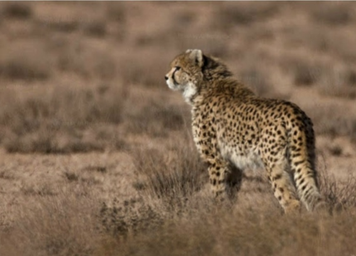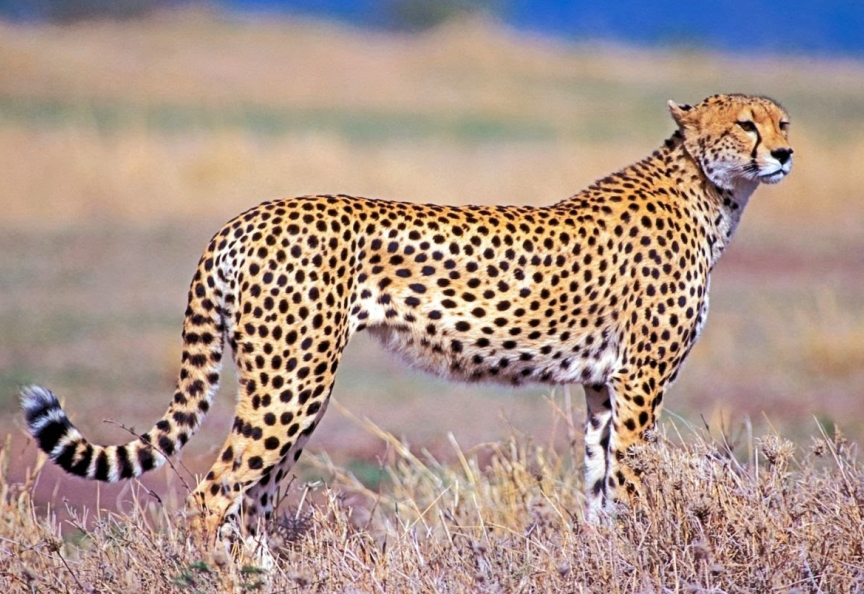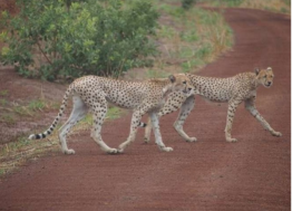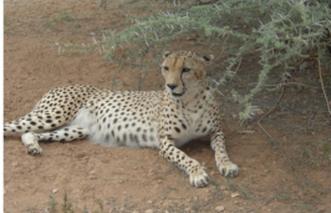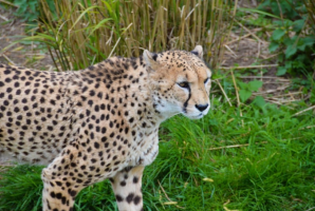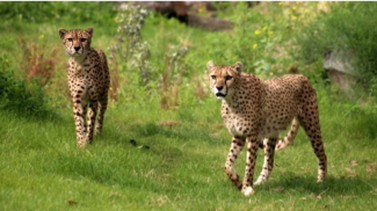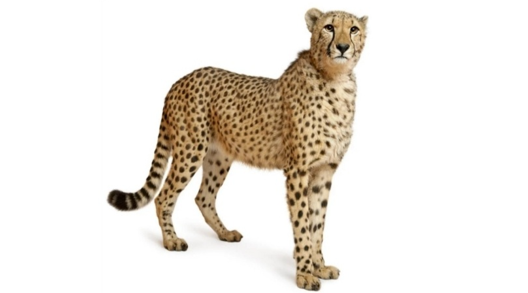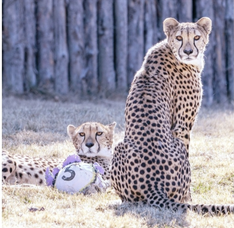CHEETAHS
Mammal - Vertebrate - Carnivore
Mammal - Vertebrate - Carnivore
|
Male: Cheetah
|
Female: She-Cheetah
|
Young: Cub
|
CHEETAHS
- The fastest land animal in the world.
- Can run as fast as 113 km per hour.
- Can accelerate extremely fast - 43 miles per hour in 3 seconds.
- Growls, hisses, purrs and snarls, but does not roar.
- Has poor night vision.
- Has extremely good eye-sight during the day.
- Has a good sense of smell.
- Hunts for food during the day.
- Cannot climb trees.
- Females are solitary animals, but males live in small groups.
- Only drinks once every 3-4 days.
- Considered to be an endangered species.
- Are the only cats that cannot retract their claws.
- Cheetah brothers stay together their whole lives, but cheetah sisters split up.
There are numerous sub-species of Cheetah.
NORTHWEST / SHARAN AFRICAN CHEETAH
Scientific Name: Acinonyx jubatus hecki.
Listed as CRITICALLY endangered, population DECREASING
The Northwest African Cheetah, also known as the Saharan Cheetah, is a Cheetah subspecies traditionally native to the entire Sahara and the Sahei. Just 50 years ago, thousands of them roamed these areas. Today, they live in very small groups found only in Algeria and Niger. Less than 250 adult Saharan Cheetahs exist in the entire world, making them one of the rarest carnivores on the planet.
The Northwest/Saharan African Cheetah is quite different in appearance from the other African Cheetahs.
1. The coat, or fur, is much shorter and nearly white in colour.
2. The spots fade from black over the spine, to light brown on the legs.
3. The entire face has few or even no spots, and the tear stripes are often missing.
4. The body shape is basically the same as other African Cheetahs, except that they are somewhat
smaller, weighing in at 77lbs - 143lbs.
The Northwest/Saharan African Cheetah is quite different in appearance from the other African Cheetahs.
1. The coat, or fur, is much shorter and nearly white in colour.
2. The spots fade from black over the spine, to light brown on the legs.
3. The entire face has few or even no spots, and the tear stripes are often missing.
4. The body shape is basically the same as other African Cheetahs, except that they are somewhat
smaller, weighing in at 77lbs - 143lbs.
NORTHEAST / SUDAN AFRICAN CHEETAH
Scientific Name: Acinonyx jubatus soemmeringii
Listed as VULNERABLE, population DECREASING
Scientific Name: Acinonyx jubatus soemmeringii
Listed as VULNERABLE, population DECREASING
The Northeast African Cheetah, also called the Sudan Cheetah, is a subspecies that lives in the grasslands of North East and Central Africa. Although they live in their traditional areas of the Sudan, Ethiopia, Somalia, Nigeria, Central African Republic, Libya and Egypt, their numbers are decreased by thousands in the last 80 years. It is believed that there are only approximately 960 remaining alive in the world today.
The Northeast / Sudan African Cheetah is quite different in appearance from the other African Cheetahs.
1. The coat is course and the darkest of all the subspecies, with a darker yellow-brown or orange
colour.
2. The spots are more numerous and closer together.
3. The belly is distinctly white.
4. The breast and throat has some spots.
5. There are NO spots on the hind feet.
6. There are distinct white patches around the eyes.
7. They have the thickest tail of all Cheetahs.
8. They have the largest head size.
9. Tear markings are the thickest at the mouth.
The Northeast / Sudan African Cheetah is quite different in appearance from the other African Cheetahs.
1. The coat is course and the darkest of all the subspecies, with a darker yellow-brown or orange
colour.
2. The spots are more numerous and closer together.
3. The belly is distinctly white.
4. The breast and throat has some spots.
5. There are NO spots on the hind feet.
6. There are distinct white patches around the eyes.
7. They have the thickest tail of all Cheetahs.
8. They have the largest head size.
9. Tear markings are the thickest at the mouth.
SOUTHERN / NAMIBIAN AFRICAN CHEETAH
Scientific Name: Acinonyx jubatus jubatus
Listed as VULNERABLE, population DECREASING
The Southern African Cheetah, also called the Namibian Cheetah, is a subspecies that lives in the grasslands and scrub forests of Central and Southern Africa. They still exist in their traditional homelands of Namibia, Zimbabwe, Tanzania, South Africa, Mozambique, Angola, Swaziland, Botswana and Malawi, but their numbers plummeted in the 20th Century.
The Namibian Cheetah was on the fast track to extinction. Once numbering near a hundred thousand, by 1980 their numbers had dwindled to barely over 7,000 and continued to drop by as much as 800 per year - all thanks to humans!
Dr. Laurie Marker moved to Namibia and started the Cheetah Conservation Fund in 1990 to save these Cheetahs, now at less than 100 adults.
By working with ranchers on real solutions, working to end the illegal Cheetah trade, educating about the shy and gentle ways of Cheetahs ... a Cheetah has NEVER killed a human, and only one attack has ever been recorded when a human was stealing cubs and the mother attacked to save her babies! The mother was viciously killed by the poachers, but the media attention brought the men to some semblance of justice. They were sentenced to 5 years in prison and now Cheetah smuggling is illegal in ALL Africa. The Cheetah numbers are now on the rise again, at 1,300 adults.
The Southern / Namibian African Cheetah is the standard subspecies all others Cheetah subspecies are compared to:
1. The coat is a golden yellow colour.
2. They have the largest black spots of all Cheetahs.
3. The faces are covered in black spots.
4. Only the neck is white.
5. The defining characteristic is a very noticeable dark moustache.
6. The tips of the tails are always black.
7. They have the wider incisors and a longer mandible.
The Namibian Cheetah was on the fast track to extinction. Once numbering near a hundred thousand, by 1980 their numbers had dwindled to barely over 7,000 and continued to drop by as much as 800 per year - all thanks to humans!
Dr. Laurie Marker moved to Namibia and started the Cheetah Conservation Fund in 1990 to save these Cheetahs, now at less than 100 adults.
By working with ranchers on real solutions, working to end the illegal Cheetah trade, educating about the shy and gentle ways of Cheetahs ... a Cheetah has NEVER killed a human, and only one attack has ever been recorded when a human was stealing cubs and the mother attacked to save her babies! The mother was viciously killed by the poachers, but the media attention brought the men to some semblance of justice. They were sentenced to 5 years in prison and now Cheetah smuggling is illegal in ALL Africa. The Cheetah numbers are now on the rise again, at 1,300 adults.
The Southern / Namibian African Cheetah is the standard subspecies all others Cheetah subspecies are compared to:
1. The coat is a golden yellow colour.
2. They have the largest black spots of all Cheetahs.
3. The faces are covered in black spots.
4. Only the neck is white.
5. The defining characteristic is a very noticeable dark moustache.
6. The tips of the tails are always black.
7. They have the wider incisors and a longer mandible.
Visit: Cheetah . COLLECTIVE NOUN
